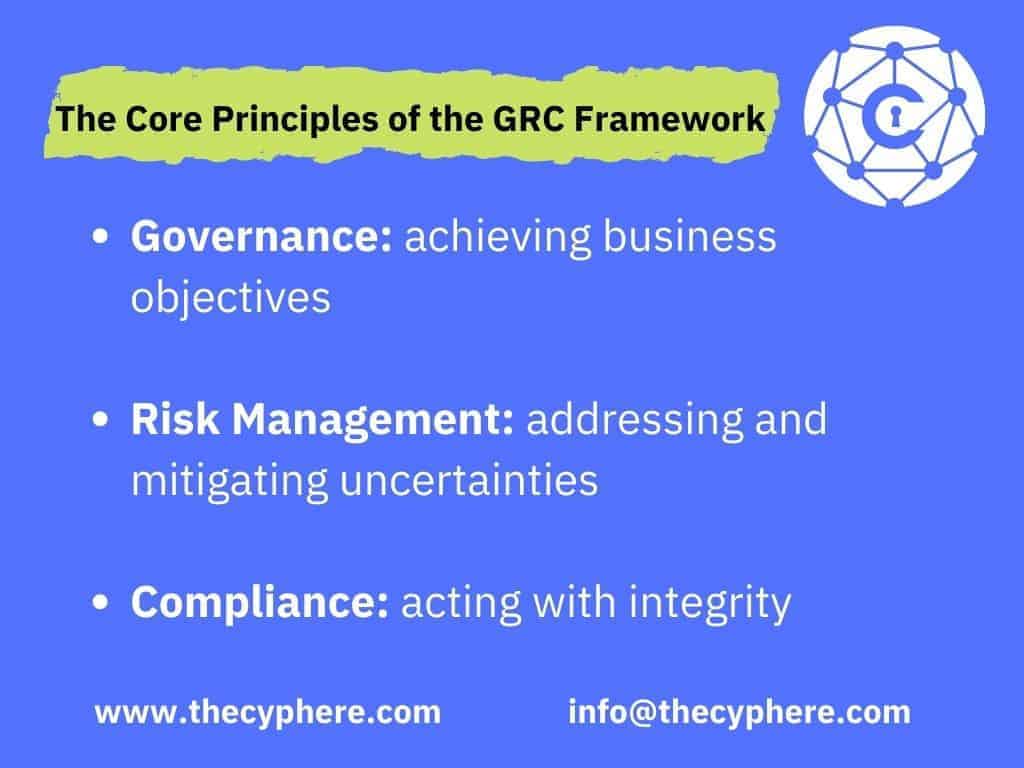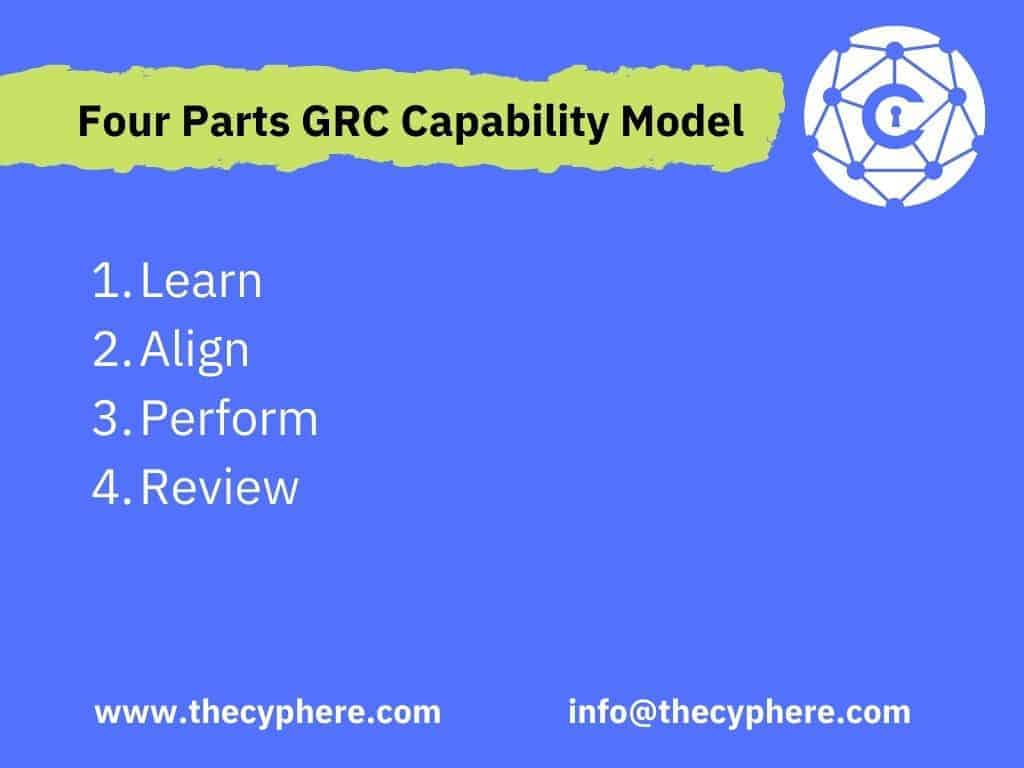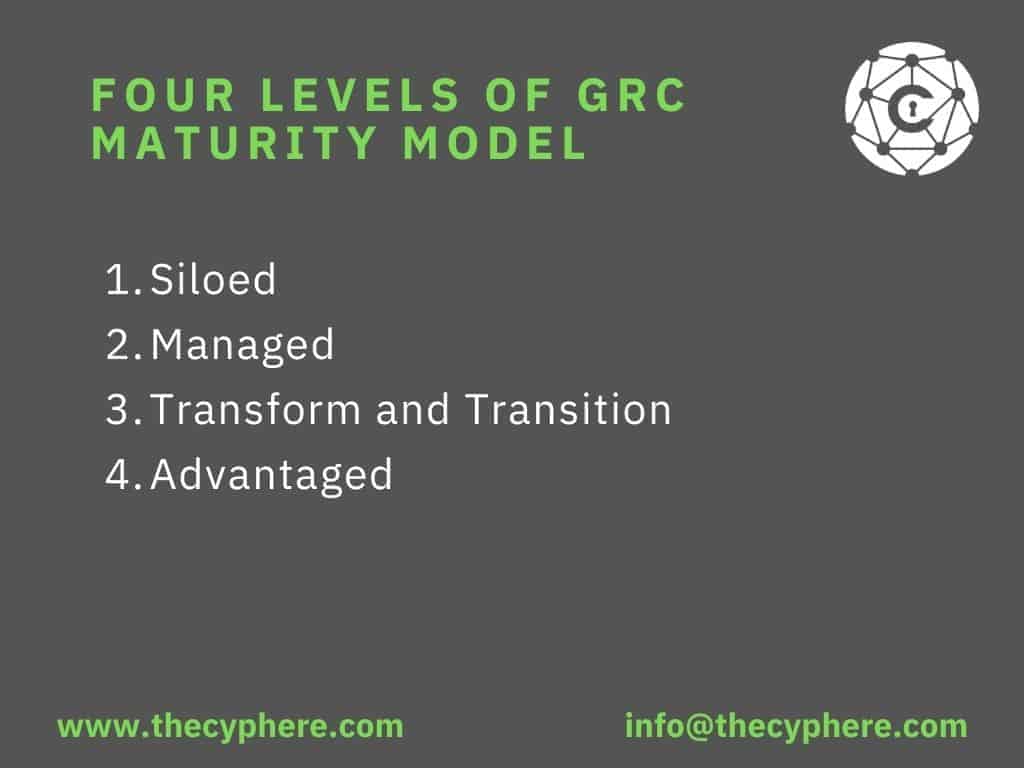
The term Governance, Risk, and Compliance (relatively known as its acronym ‘GRC’) is an integrated strategy for managing an organisation’s overall governance procedures, enterprise risk management, and regulatory compliance.
As an integrated GRC approach, the concept describes a variety of organisational activities, ranging from conducting an internal annual audit to establishing continuous control monitoring procedures, assigning roles and responsibilities to business unit processes as well as users, and implementing data analytics procedures.
The majority of the content on this blog will be on GRC solutions in the context of information technology and cybersecurity principles.
What exactly is GRC in the context of cybersecurity?
As a principle concept of cybersecurity, (GRC) Governance, Risk, and Compliance is considered a method for aligning IT goals with business objectives while also effectively managing cyber risks and achieving regulatory needs.
GRC in cybersecurity is the incorporation of data security and privacy into governance, risk management, and compliance processes. Because any organization’s foundation is based on its information technology infrastructure, cyber risk is no longer considered separate from any other sort of business risk. By deploying GRC tools and technology, the approach centralises all compliance needs, including data privacy compliance, in one convenient location.
GRC also provides a framework for integrating security and privacy with an organisation’s overall objectives, allowing businesses to make informed decisions regarding data security risks rapidly, and preventing the risk of compromising privacy.
To view a concise version of this article, we invite you to watch our video on the same topic.
From where did the term come from?
It should be noted that PricewaterhouseCoopers (aka PwC, an international professional services network of organisations) first coined the term GRC in 2004, and it has since grown in popularity as a key developing solution for an organisation’s compliance requirements.
Understanding the core principles of the GRC Framework
The three core principles of GRC are explained below:

Governance: achieving business objectives
Governance can be described as the methods used to direct and control an organisation. Governance is the foundation of the whole GRC approach required to determine the organisation direction through procedures and policies. It also helped to monitor performance, controls, and assess outcomes.
Risk Management: addressing and mitigating uncertainties
Risk is the potential occurrence that could result in harm or loss, or make achieving goals more difficult. Risk management in GRC guarantees that the organisation identifies, analyses, and controls cyber risks that could affect a well planned GRC strategy.
Compliance: acting with integrity
Compliance is the act of ensuring that a set of instructions or a standard is followed, or that proper, consistent accounting or other processes are used.
Compliance guarantees that the organisation takes measures and implements control to ensure that compliance obligations are satisfied consistently, depending on the circumstances.
Traditionally, these three activities were carried out in a more or less independent manner. Each of the three disciplines in a GRC approach continues to interact with and support existing business operations, but the benefits are realised at the intersection of the three.
GRC Capability Model
It should be noted that governance risk and compliance work best when deployed comprehensively throughout the entire enterprise.
This does not always necessitate the use of an umbrella unit for coordination, while it may be appropriate for some types of entities.
The OCEG has established this Capability Model (also known as the Red Book) as an open-source methodology that integrates the many sub-disciplines of governance, risk, audit, compliance, ethics/culture, and IT into an order to function successfully.
The Capability Model is comprised of four parts:

1. Learn
The first part describes an initial point of every GRC program i.e Learn about the organisations’ goals and strategic objectives.
Strategic objectives are broad expressions of intent that serve as a link between your vision and your annual plan or goals. Strategic objectives are sometimes referred to as “mini vision statements” since they should complement your overarching vision of success while breaking it down into achievable and actionable emphasis areas.
The main idea is to identify the business culture, stakeholders, and business practices of the organisation in order to successfully guide their goals and objectives.
As a whole the whole process can be done by doing:
- Learning business goals
- Learning strategic objectives
- Learning ongoing compliance activities
- Learning the key stakeholders
2. Align
Following the learning of the business goals and strategic objectives, the necessity for action arises through effective decision making with the backing of senior leadership.
Enterprise GRC is entirely dependent on the executive suite determining corporate compliance. As a result, the requirement for an integrated approach to stakeholder expectations with executive backing supports the objective of good governance.
In a nutshell, this procedure necessitates:
- Align your business objectives with your strategic objectives.
- Align the support for executive suits with stakeholder expectations.
- Align the resource allocation planning to carry out what was decided.
3. Perform
After aligning the business goals and objectives the need of doing practical steps arises. This step describes implementing appropriate controls and policies, preventing the GRC risks by mitigating them in the first place, monitor the overall infrastructure to not be compromised.
As a whole:
- Perform enterprise risk management ERM
- Perform risk remediation strategies
- Perform an internal audit to manage risk arising from poor governance and compliance.
4. Review
Review the strategies and operational performance, as well as the continued appropriateness of objectives to enhance the integrated GRC activities.
As a whole
- Perform the right set of activities to monitor the overall governance risk and compliance challenges.
- Perform continuous monitoring to keep up to date with legal and regulatory requirements.
These components establish an ongoing continuous improvement process to reach fundamental performance, and they are further subdivided into actions and controls.
The actions and controls are categorised into three groups, from which companies can choose a combination based on their context i.e.
- Proactive control is taking preventive actions to plan for uncertainty, as well as having policies and procedures in place to govern.
- Detective control involves, at a minimum, employing event detection and log monitoring tools to identify any uncertainty as it occurs.
- Responsive controls are prepared to address uncertainty by responding and minimising its influence at the simplest authentication solutions, firewalls, and antivirus software.
The importance of GRC in an organisation
Today’s organisation is surrounded by increased cyber threats as well as expanding regulatory compliance issues. A systematic approach is required to properly safeguard people, processes, and technology.
GRC plays a significant role in helping those who are in need. GRC’s value in organisations may be seen by examining its benefits, i.e.
- It lowers the operational costs and regulatory fines;
- Provides a higher level of leadership effectiveness in all domains of the organisation;
- Formulating a better understanding of risks, threats, and vulnerabilities;
- Adhering to relevant norms and rules continually;
- Protection from unfavourable internal audits, financial penalties, and litigation.
- Risk reduction across the board, including business risks, financial risks, operational risks, and security threats.
It should be noted that potential challenges may arise if GRC is implemented incorrectly or if top management support for GRC is insufficient. High expenses associated with non-compliance, inadequate performance as a result of poor risk visibility, and fragmentation among the organisation’s departments and personnel are all issues.
What is the GRC maturity model?
The Maturity Model for integrated GRC focuses on gradually developing the four levels of capabilities mentioned below and implementing the overall strategy as a series of tactical intelligently designed activities.

1. Siloed
The Siloed stage focuses on the baseline activities required to manage risk and serves as the starting point for all subsequent stages.
At this stage, the organisation’s strategy is not inherently inadequate, but coordination between functions is severely constrained.
2. Managed
The Managed stage determines the phase at which organisations reach a coordinated, sustainable GRC maturity.
The GRC program, at this point, is effective and achieving its objectives but is still lacking the critical connection to the business that will turn the effort into a valuable contributor to the business strategy.
3. Transform & Transition
The Transition and Transform stages assist the company in “moving to the next level” with efforts that critical capabilities are evolving, and the scene is being prepared for advanced capabilities.
4. Advantaged
The Advantaged stage is intended to be reachable for the majority of enterprises. This is not an ‘idealistic, wishful thinking’ goal, but rather an advanced stage of maturity that optimises the GRC programme.
At this point, risk management and compliance are integrated into business processes, and the organisation benefits from well integrated GRC.
Do’s and Dont’s of GRC activities
Managing governance, risk management and compliance are one of the most critical and complicated activities of the firm. Keep these dos and don’ts in mind while your organisation develops a GRC program.
Do’s
- Prepare to use a business case to support the integration of GRC activities.
- Obtain senior management and funding support for a GRC program.
- Examine the various methods of a GRC program and create a project plan.
- If the software is part of the plan, use caution while selecting a software product.
- Prepare and deliver awareness and training efforts to sell the value of integrated GRC operations to employees and management.
- Recognize that not all employees will enthusiastically embrace a GRC program; ensure that those who stand to benefit the most are on board.
- Collaborate with IT to create an efficient system rollout plan.
- Allow employees to test the system before it is put into production.
- During the testing time, take careful note of employee opinions and communicate them with the technology vendor.
- Provide regular updates to top management and employees on the status of the initiative.
- Implement the deployment; monitor for issues and rectify them as soon as possible.
- Create system maintenance and updating procedure.
- Ensure that the new system is incorporated in technology disaster recovery plans.
- Create a plan to monitor program success and share data with staff and management.
- Involve third party risk management vendors
Don’t do the following when planning a GRC program
- Don’t assume that implementing an integrated GRC program will benefit the organisation; it might not.
- Don’t expect senior management to embrace a GRC program right away.
- Don’t expect employees to embrace a GRC program, especially if it entails changing the way they’ve done their jobs for years.
- Don’t forget to look into the many methods of a GRC program, as well as a maturity model.
- When deciding if an integrated GRC approach would work, don’t undertake a cursory review and analysis of business processes; instead, learn as much as you can about the firm.
- Don’t be afraid to reach out to other firms to check if their GRC strategy succeeded; this is especially crucial if GRC software is being explored.
- Don’t forget to work with IT throughout the process.
- Don’t presume that employees and management will attend awareness and training events; this is where management assistance might be useful.
- Don’t overlook the significance of developing a project strategy for the adoption of a GRC system.
- Don’t be disappointed if management decides to postpone or cancel the program.
Get in touch to discuss your security concerns around GRC, processes or technological controls or how to create a GRC program for your business.
Shahrukh, is a passionate cyber security analyst and researcher who loves to write technical blogs on different cyber security topics. He holds a Masters degree in Information Security, an OSCP and has a strong technical skillset in offensive security.












